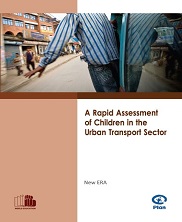Child labor in Nepal is a serious concern. Around 40% or 3,140,000 of the 7,700,000 children aged between 5 to 17 years are engaged in work. Of this 3,140,000, about half or 1,600,000 child laborers are in exploitative working conditions; and about 621,000 are in hazardous work. Children are found working in carpet and entertainment industries, mining, bead making, portering, brick production, embroidery (zari), car/motorcycle repair workshops, domestic work, cross border smuggling and roadside hawking. Each sector has its own array of push/pull factors influencing entry and exit of children and which determine the nature and extent of exploitative work children are exposed to. World Education’s Naya Bato Naya Paila project funded by United States Department of Labor commissioned rapid assessments in four sectors – brick kilns, domestic service, mining and portering – having high incidence of child labor, to provide an update on the status of children working in these sectors. Rapid assessments in two additional sectors – urban transport and teashops and restaurants – were conducted in collaboration with, and financial contribution from, Plan Nepal. The Ministry of Labor and Employment/MoL&E (formerly Ministry of Labor and Transport Management/MoLTM) provided advisory inputs. The Ministry of Women Children and Social Welfare, Central Bureau of Statistics, Ministry of Federal Affairs and Local Development, UNICEF and ILO have been part of this research as members of the Working Committee, along with Plan Nepal and MoL&E.
The key objective of this rapid assessment research is to provide updated information on the current situation of children in Nepal engaged in the transport sector. The overall analysis of quantitative and qualitative data is primarily guided by the two major ILO Conventions, namely, UN Convention on the Rights of the Child (CRC), and Convention on Worst Form of Child Labor (WFCL). World Education, 2012.


